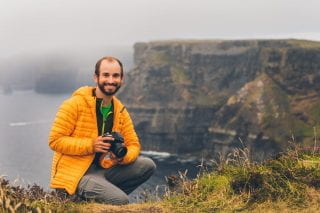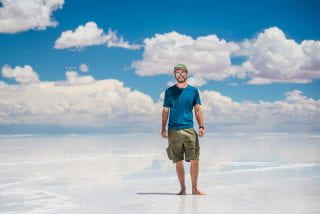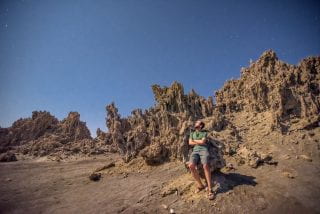A Q&A with Fulbright College Alumnus Stephen Ironside
Stephen Ironside
Photographer and 2010 Graduate of the Fulbright College Honors Program,
B.S. in Biology and Anthropology with minor in Spanish, Cum Laude
In this conversation, Ironside talks about how studying biology and anthropology enriched his photography; creating his own business and having photo adventures all over the world; the importance of studying abroad and the difference it made in his life; how essential it is for students to get outside of their comfort zone and try new things; being a new dad; and his upcoming exhibition in the Arkansas Union, titled “Same Same But Different.”
Q: Can you tell us a little about your career, what you studied in college, and how the two relate to one another?
Late in high school here in Fayetteville, I decided I wanted to be a photographer. Though I wanted to go elsewhere for college — like most kids do — I received an Honors College Fellowship at the U of A, which basically dictated that I could (and should!) stay in Fayetteville for my undergraduate career.
Unfortunately, in 2006, there was no real photography program available. No major, and not even a minor — just a fine art degree where I could get an “emphasis” in photography while having to take other art classes I wasn’t really interested in. I decided, instead, to study what I eventually wanted to create images of — nature and people — and settled on studying biology and anthropology.
I reasoned that if I learned more about what I wanted to capture in images, I’d do a better job at it. I taught myself photography along the way, shooting for The Arkansas Traveler and The Razorback (the student newspaper and yearbook) and practicing with some portrait and wedding work. After I graduated, I thought that I needed to get an M.F.A. in order to practice photography professionally, which turned out to be a false perception. After applying to and getting rejected by six M.F.A. programs, I realized that wasn’t what I wanted to do anyway. I took a leap and started my photography business.
Now, 10 years later, I’m working to expand my commercial, corporate, advertising, and editorial photography business to a more regional and national scale. Long term, I’m pursuing storytelling photography as both a profession and a life goal and hope to help revitalize peoples’ love for the natural world and for cultures besides their own — a love that seems to have been lost in today’s society.
I dream of working abroad with nonprofits and NGOs that focus on environmental or cultural conservation, and I hope that my studies in biology and anthropology and learning another language helped prepare me for that.
Q: What have been one or two of the most interesting or exciting accomplishments for you in your career or life post-college?
Storytelling through visual imagery has already brought me many opportunities, both during and after college.
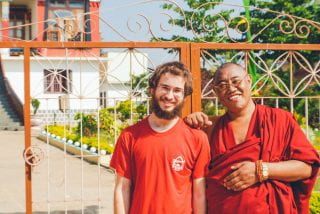
Visiting with Geshe Phuntsok Tsundue, a Tibetan monk who took care of Ironside at the Drepung Loseling Monastery in southern India, in 2008 at the end of a semester abroad.
I’ve shot for both Fortune 100 companies and mom and pop restaurants, but I’ve also documented clothing factories in India, a wedding in Bolivia, deadly snakes in Costa Rica, electronics factories in China, and an ancient religious ceremony in the middle of nowhere in the Himalayas.
But it doesn’t matter if I’m abroad or right at home in Arkansas; looking through the lens to craft a story and share it with others, and to see their reactions and how it can impact their lives, is what gets me up in the morning… oftentimes before sunrise.
It’s better than the awards I’ve won, and it’s better than that tingly feeling of being published. I’m happy I’ve been able to survive on my own as a not-so-starving artist as a self-taught photographer in a world full of them and feel like I’m just getting started.
Q: What was one of your favorite memories of your time at the college and why?
Most of what I reminisce about from my “college days” are things that happened while I was studying abroad. Sharing tea with monks in a monastery in southern India, watching lava flow out of a volcano on Lake Nicaragua, seeing the stars at 15,000 feet in the Nepali Himalayas.
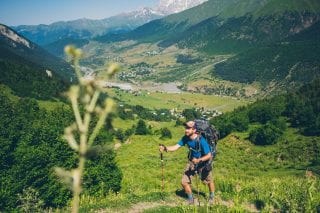
Backpacking in the Caucasus mountains near Mestia in the Republic of Georgia in 2018. Photo by Tristen Wylde.
Don’t get me wrong: I had lovely experiences on campus, including a few key classes (Geshe Dorjee’s Tibetan Culture class, Justin Nolan’s Environmental Anthropology class, Peter Ungar’s Human Evolution class come to mind), made some great friends in the dorms, and got to meet a lot of great people shooting for the newspaper and yearbook.
But I spent my whole junior year out of the country, and it was a life-altering experience. After spending the fall semester of 2008 in India and Nepal studying Tibetan and Himalayan culture through SIT, fulfilling requirements for my Anthropology major, I turned around and headed to Costa Rica to study tropical biology for a semester through Duke University and the Organization for Tropical Studies.
Both were incredible experiences that I wouldn’t trade for anything. India was my first time out of the country, and it opened my eyes, mind, and heart to the rest of the world in a way that can’t be put into words in the space allotted here. Costa Rica helped me hone my Spanish skills in a more authentic way and gave me the experience in science that I hadn’t yet gotten in Fayetteville.
I made some lifelong friends from all over the world that I’m still in touch with and have visited (or who have visited here). The travel bug has taken me to no fewer than 17 countries so far, all thanks to that first day in Delhi.
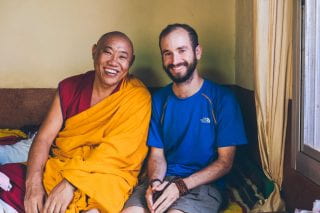
Visiting with Geshe Tsundue again in 2017. Photo by Adams Pryor.
I’m grateful for the Honors College for allowing me to use scholarship funding for those purposes and to the Office of Study Abroad for helping me navigate such magnificent waters. ]
Q: Now that you’ve achieved so much in your career, what advice would you give to students?
Get out of your comfort zone. Go abroad, if you can. Experience the rest of the world, not just our own tiny corner of it.
And I don’t mean just study for a summer in France, because that’s easy; spend a semester in Indonesia, or Ecuador, or Namibia, or at least a summer in Nepal.
The more different the place and the people are than what you’re familiar and comfortable with, the more you’ll get out of the experience and the more it will change your future. There are resources out there to help make it happen; just ask.
That, and do your homework… and try not to form the bad habit of spending all of your money (or flex dollars, if they’re still called that) at Chick-Fil-A.
Q: What do you like to do during your time outside of work?
Work/life balance is incredibly important, though it’s hard for me.
When not taking photos, you can usually find me at the computer editing them (which is also work), working in the garden, cuddling my better half, giving our pup a belly rub, out on a hike or backpacking trip, cooking or eating Indian food, or on the road cycling because of eating Indian food. And, as of this year, playing with our newborn babe.
I also serve on the board of the Himalayan Village Fund, a local organization providing education to impoverished children in rural Nepal. My “Coronavirus Project” has been converting a minivan into a camper.
Q: What’s up next on the horizon for you?
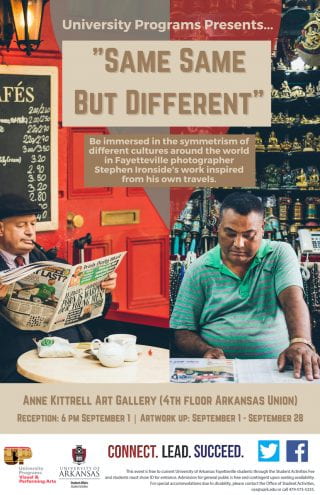
That’s hard to say right now. I had a baby in January, so right now, my current adventure is learning how to be a good dad. Travel plans are off with the coronavirus still in play, so I’m enjoying some time at home.
I’m hoping to both expand my commercial photography comfort zone and capabilities while trying to find nonprofits and NGOs that want me to do some travel work.
Q: Is there anything else you’d like to add or let readers know?
I’ll be having a gallery show at the Anne Kittrell Gallery in the Arkansas Union for the month of September, featuring images from my travels.
Entitled “Same Same But Different,” it will feature pairs of images from different countries — at least 12 countries in total — that attempt to show that the world’s people and cultures, though they have their differences, are ultimately much more similar than we’d think.
I thought it was an important idea in a time when xenophobia and fear of those “different” from us seems to be at a peak and hope that viewers will be able to see a little of themselves in the images as well.
The images in the show will swap out for new ones about halfway through the month, so it’s worth a visit both now and later.
Feel free to follow along with my journey on Instagram @ironsidephoto, via my Facebook page, or on my website.


